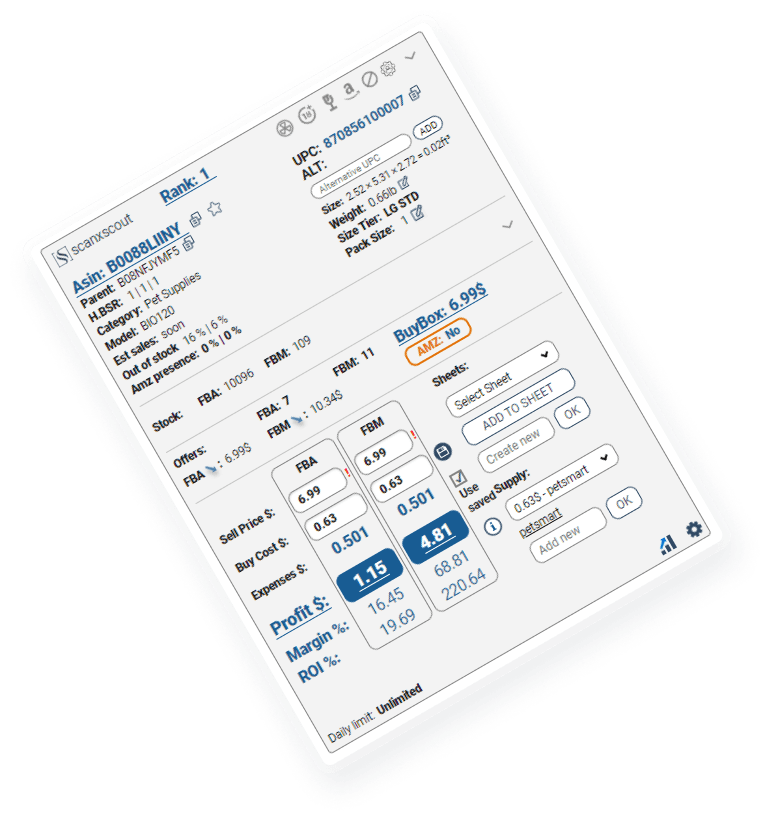Amazon FBA (Fulfillment by Amazon) has revolutionized the e-commerce landscape, offering sellers a robust platform to reach millions of customers globally. However, understanding the financial nuances, especially the profit margins, is crucial for long-term success. This article delves into the intricacies of profit margins for Amazon FBA, providing detailed insights and strategies to optimize your earnings.
Understanding Profit Margins in Amazon FBA
Profit margin is a critical metric that indicates the percentage of profit you make from your sales after accounting for all costs. For Amazon FBA sellers, these costs include manufacturing, shipping, Amazon fees, and marketing expenses.
Calculating Profit Margin
To calculate the profit margin, use the following formula:
Profit Margin (%) = [(Revenue – Costs) / Revenue] x 100
For example, if you sell a product for $50, and your total costs amount to $30, your profit margin would be:
Profit Margin (%) = [($50 – $30) / $50] x 100 = 40%
Key Cost Components
Understanding and managing the key cost components is essential for maintaining a healthy profit margin. These components include:
- Product Cost: This includes manufacturing, packaging, and shipping from the supplier to Amazon’s warehouse.
- Amazon Fees: These are the fees Amazon charges for storing, picking, packing, and shipping your products. It also includes referral fees, which are a percentage of the selling price.
- Advertising and Marketing Costs: Expenses related to promoting your product on Amazon and other platforms.
- Miscellaneous Costs: These can include returns, damaged goods, and other unforeseen expenses.
What Constitutes a Good Profit Margin?
A good profit margin for Amazon FBA sellers typically ranges between 15% and 30%. However, this can vary significantly based on the product category, competition, and overall business strategy.
Industry Benchmarks
- Low-Margin Products: Categories such as electronics often have lower profit margins, sometimes as low as 5% to 10%. This is due to high competition and significant price sensitivity.
- Mid-Margin Products: Health and beauty products, home goods, and toys generally offer mid-range margins of 15% to 25%.
- High-Margin Products: Niche products, luxury items, and private label goods can command higher margins, often exceeding 30%.
Strategies to Improve Profit Margins
Improving profit margins requires a combination of cost management and revenue enhancement strategies. Here are some effective tactics:
Optimizing Product Costs
- Negotiate with Suppliers: Establish strong relationships with your suppliers and negotiate better rates based on volume discounts or long-term contracts.
- Source from Multiple Suppliers: Diversifying your supply chain can help you find more competitive pricing and reduce dependency on a single supplier.
Reducing Amazon Fees
- Optimize Inventory Levels: Avoid overstocking to reduce storage fees. Use tools to predict demand accurately and maintain optimal inventory levels.
- Utilize Amazon’s Small and Light Program: For eligible items, this program can significantly reduce fulfillment fees.
Enhancing Revenue
- Improve Product Listings: Invest in high-quality images, detailed descriptions, and optimized keywords to increase conversion rates.
- Leverage Amazon Advertising: Use targeted advertising campaigns to boost product visibility and sales. Monitor the performance regularly and adjust your strategy accordingly.
Managing Advertising Costs
- Utilize Pay-Per-Click (PPC) Campaigns: PPC campaigns can be highly effective but need careful management to avoid overspending. Regularly review and optimize your ads to ensure they remain cost-effective.
- Focus on Organic Growth: Enhance your product’s organic ranking through SEO optimization, gathering reviews, and maintaining high seller ratings.
Monitoring and Adjusting Pricing
- Dynamic Pricing Strategies: Use dynamic pricing tools to adjust your prices based on competition, demand, and other market factors.
- Implement Bundling: Offer product bundles to increase average order value and improve profit margins.
Case Study: Successful Amazon FBA Seller
Consider the case of a seller in the health and beauty category who managed to achieve a 25% profit margin. By sourcing products from a reliable supplier at competitive rates and optimizing their Amazon listings with high-quality images and keywords, they increased their conversion rates significantly. Additionally, they utilized Amazon’s PPC campaigns efficiently, ensuring a controlled ad spend while maintaining a steady sales volume.
Conclusion
Achieving and maintaining a good profit margin in Amazon FBA requires meticulous planning, continuous monitoring, and strategic adjustments. By understanding the key cost components, setting realistic profit margin targets, and implementing effective cost management and revenue enhancement strategies, sellers can optimize their earnings and ensure long-term success on the Amazon platform.


 632
632